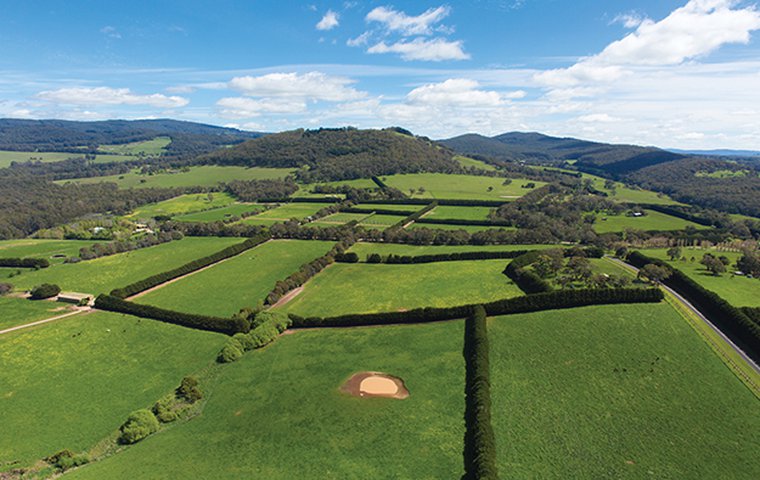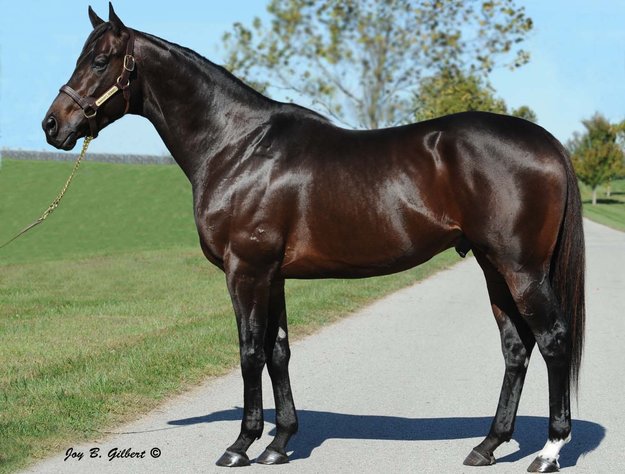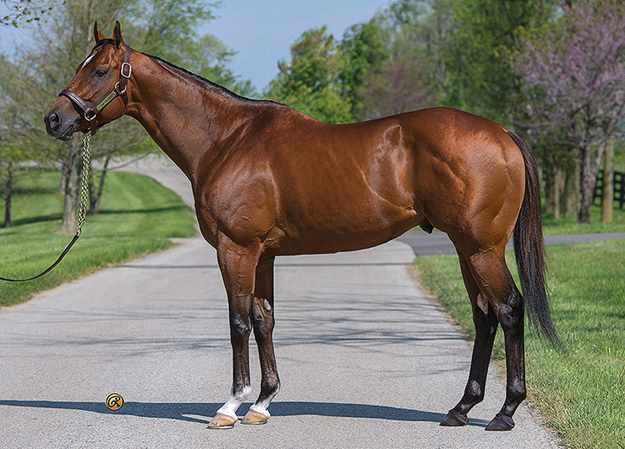
B. Wayne Hughes’s Spendthrift Farm extended its reach to Australia this year by purchasing Yallambee Stud in Victoria. That move opens up a new Southern Hemisphere operation for the Lexington, Kentucky-based farm, which intends to be active in all facets of Australia’s Thoroughbred industry as a breeder, stallion owner, racehorse owner, and buyer and seller at auctions. The Australian venture also presents the opportunity for Spendthrift to expand its breeder-incentive programs, Share the Upside and Breed Secure, into the Southern Hemisphere stallion market.
Spendthrift Australia will stand four stallions during its inaugural breeding season: Warrior’s Reward (by Medaglia d’Oro), whose runners include 2015 G1 Wood Memorial runner-up Tencendur and stakes-winners Requite and Warriorscmoutoplay; Jimmy Creed (by Distorted Humor), whose first foals arrived in the Northern Hemisphere this year; record-breaking Australian G1 winner and the Australian-bred first-year stallion Hampton Court (by Redoute’s Choice); and U.S. G1-placed stakes-winner Can the Man (by Into Mischief), who entered stud in Kentucky this year. Each will be offered with a limited number of Share the Upside options. Share the Upside allows a breeder to earn a lifetime breeding right in the participating stallion by paying a one-time AU$275 deposit and signing two breeding contracts for the stallion, one for 2015 and one for 2016. When the mare or mares produce two live foals and the stud fees on those foals are paid, the breeder earns a lifetime breeding right starting as early as 2017.
Spendthrift pioneered such breeding incentive programs, which have proven controversial with some rival stallion farms even as others have been inspired to adopt the incentives or create their own versions. How Australian breeders and the local auction buyers respond to the Spendthrift program, its sires, and their progeny remains to be seen. But Spendthrift Farm general manager Ned Toffey notes that, at a time when the Thoroughbred world is shrinking and Australia’s Thoroughbred racing and sales are doing lively business, Spendthrift has spotted an opportune time to go international with its value-based marketing message. Thoroughbred Racing Commentary contributor Glenye Cain Oakford interviewed Toffey in May.
----------
Why does Spendthrift feel these four stallions, in particular, suit the Australian market now?
“I think one thing we’ve learned is that commercial breeders, [there] in particular, are looking for some specific things. There are certainly exceptions to these things, but predominantly it’s a market driven by speed and precocity. So in discussing our current roster in America with a number of people, these are the horses that we came up with that suit most, based on what sire lines have worked, on what they look like physically, and what their attributes were as racehorses.
“Warrior’s Reward [Share the Upside fee AU$13,750 or AU$11,000 stands and nurses] was a horse that we were on the fence about, but Medaglia d’Oro siring a Golden Slipper winner in Vancouver certainly made that decision much easier. And Warrior’s Reward is quite a big horse—they like a big, strong horse with a lot of bone and very correct. He is that.

“Jimmy Creed [Share the Upside fee AU$11,000 or AU$8,800 stands and nurses] is a horse people had expressed some interest in, because his sire Distorted Humor had been down there. We heard some varying opinions on how well he did down there, but if you look at him statistically, while he was only there a brief time, he was actually very productive. Jimmy Creed, with all of the speed that he demonstrated and that the Distorted Humors routinely demonstrate, and the amount of speed in the female family, we thought he really suited. He’s a similar type, maybe a little bit lighter than the breeders down there might be used to, but he’s the right shape. I think he’ll complement the mares they’ve got down there, because they are very substantial mares. He’s a nice physical complement. And he’s a young stallion.
“Can the Man [Share the Upside fee AU$5,500 or AU$3,850 stands and nurses] is a horse who was very precocious and talented. We’d decided not to take Into Mischief down to Australia, but we wanted to take a son. With the Danzig influence on his female family, it was something they could relate to pretty well. Physically, he probably is most typical of what you would run into in Australia. He’s very stout, maybe a little bit lower to the ground, but very stout with good bone and correct. He’s a very fast-looking horse and, in fact, was a fast horse. That is also the family of Redoute’s Choice. His pedigree is as strong as they get. So while his race record is a little bit limited, there’s so much pedigree and so much conformation, and so much brilliance demonstrated. One of the things we’ve had good success with is horses that maybe didn’t have the overall resume; if they did, they’d have been really expensive horses. But they had demonstrated that ability, and he certainly did that.
“Hampton Court (AUS) [Share the Upside fee AU$11,000 or AU$8,800 stands and nurses] fits the profile, too. He’s a Group 1 winner [in Australia]. He may not possess the body of work that some other stallions have, but he obviously demonstrated Group 1 ability, so there’s tremendous talent there. Genetically, he’s got the potential to be anything. He’s by a legendary sire of sires in Redoute’s Choice. He’s got a huge pedigree that anybody can identify, but we also like it because there’s some American influence there, as well. We think he’s a horse we can offer at a really good value to breeders. And we’re looking forward to fitting him into both hemispheres.”
You mentioned that you particularly wanted to send a son of Into Mischief. Why is that?
“People there have expressed a lot of interest in Into Mischief. He’s a very popular horse for us. And at some point we may entertain sending Into Mischief down there. But, for now, it’s something we didn’t want to do. We bought the farm fairly late in the game this year, and so as we see how things go and work out the kinks, we may consider expanding on the roster. Into Mischief is what we feel is an emerging stallion, and so to get his sons out there is only going to help him, the more chance we can give him to be a sire of sires.”
How does Australia’s need for outcrosses affect what you’re doing there?
“It’s something we’ve certainly thought about with our stallions and will continue to think about moving forward. There’s something to be said for giving people something they’re familiar with, but, at the same time, Danehill has been such a huge influence down there that there’s no question they’ll need alternatives. That will play into what we do moving forward.”
You’ve got a young stallion roster in Australia. Is it harder to easier to market the less-proven stallion there?
“We’ll find out what the subtleties and differences are in terms of the markets between here and there, but our approach is to try to offer people value and try to offer people an interest in that horse’s success. That’s been the formula that’s worked here, so that’s what we’re looking to do again. … Warrior’s Reward is getting to be an established sire, so that should play well. Can the Man is brand new. Jimmy Creed has foals, and you’d probably rather start off with a first-year horse, but he was a horse that seemed to appeal to people, and we’ve gotten just tremendous feedback on Jimmy Creed’s foals, so that gave us some confidence.”

Have you also been breeding any Spendthrift horses on Southern Hemisphere time?
“In each of the last three years, we’ve foaled a number of mares on Southern Hemisphere time. We have 15 weanlings here that were foaled on Southern Hemisphere time last fall. They’re predominantly by Malibu Moon, but the crop that we have in the bellies of some of our mares is a little more diverse. We’ve got some Warrior’s Rewards and some Into Mischiefs and Temple Citys as well as some by Malibu Moon. We’re starting to spread it around a little.”
What’s your plan for those foals?
“We haven’t taken any of those to auction, but we have sold a number of them privately, and we’ve retained some to race. We’ve actually just put two Malibu Moon yearling colts, soon to be 2-year-olds, into quarantine that we’ll ship to Australia and train there. We’re looking forward to that.”
And how does that help market Spendthrift and its stallions in Australia?
“No. 1, it will demonstrate a commitment to the market and the industry there, but part of the reason that we shifted away to breeding so many to Malibu Moon was, as an 18-year-old, he’s not really a candidate to shuttle. So we’ve shifted away from just looking for a nice potential racehorse to getting something that may help us moving forward in terms of a stallion that may stand there. That’s why we’ve shifted in terms of what we’re breeding on Southern Hemisphere time.”
What’s your assessment of the Australian stallion market at the moment and how do you think the Share the Upside and Breed Secure programs might work there?
“I think breeders anywhere are going to look for value. That’s something we debated at great length, the differences between the Australian market and the American market. Our programs, and particularly the Breed Secure program, are very commercial-oriented. And the Australian market is very commercially driven. The market seems extremely strong right now. But, at the end of the day, breeders anywhere are looking for value. If you’ve got to pay really high stud fees and you get a couple of bad foals—and even if you breed to the best stallions, you’re going to get plenty of foals that are not the kind of individuals you’re looking for. So when you’re on the hook for a really big stud fee for one of those, and you’re disappointed, that’s a pretty big hit to take.
“When we’re able to offer the value of earning a breeding right, the breeder’s a little more protected in that case. And the fact that they’re getting something for helping us make a stallion successful, it’s just good value. People anywhere are going to appreciate that, as long as you offer them the right product.
“I’ve still got a lot to learn about the Australian stallion market, but it’s quite strong, and a really accomplished horse sells for as much or more there as it does here. The Golden Slipper winner seems to have a nearly absolute value of $35 million to $40 million. The colt that wins…has tremendous value as a stallion prospect, but that race also seems over the years to have a strikingly high correlation to success at stud. On average, I think you’re looking at more money to buy a horse down there. It is very similar to us in that, as you go around, you’re seeing a variety of different sire lines represented. It’s probably not quite as diverse as ours, and there’s probably a more consistent type, physically, that they’re looking for. They breed for what they’re looking for: fast and sound.
“They put maybe even more of a premium on speed than we do. So the fact that it’s both very speed-driven and very commercially-driven maybe gives it more similarity to our market. But I would say that those things are true to an even greater degree there than they are here.
“The Hunter Valley is very much analogous to the Bluegrass region here. But one of the things that we like about Melbourne is that, unlike the regional markets in America, there’s not as much of a cap on a stallion. So you’re seeing stallions standing for $25,000 and $35,000 in Melbourne, whereas in the regional markets here, there’s a much lower cap. We really liked the market there, and we liked the racing and the whole set-up. We like all of Australia, but we felt like that area really fit us well.”
Where do you see the money for horses coming from there? Are syndications popular?
“There are a lot of racing syndicates. One thing I found interesting was that at the Magic Millions sale back in January, Gai Waterhouse had a booth set up, and you could see right there how many spots were left in a given horse that had been purchased. You could buy a share in a horse there. They were basically syndicating a horse right before your eyes.”
What about for stallions? Coolmore and Darley are both big players there, of course, but is syndication seen much there?
“I believe that there is a good amount, but that isn’t the model we’ll use. We’ll use the Share the Upside model and look for that to work well.”
Share the Upside has met with some controversy here, and I wonder whether you’re expecting similar controversy in Australia, not so much among breeders, but among established stud farms?
“I can’t say we’ve encountered a great deal of real resistance. I think there’s a great deal of curiosity to see what we do and how well it works. We’ve gotten a broad base of reactions to it. There are a lot of people who love the innovation, and there are a lot of people who don’t like change. But the feedback we’ve gotten there has mirrored what we’ve gotten here pretty closely.”
What are some of the challenges you see there?
“Learning the nuances. There are certainly a lot of differences, but there are also a lot of similarities between the markets here and there. I fully expect that we might have some stallions that don’t work out there, but we’re looking forward to this, and we think that this is something that can work. Offering breeders value is something we think will work anywhere.”
I’ve heard that yearlings from Victoria’s cooler climate sometimes can appear a little later-maturing. Are you going to aim your yearlings in Victoria for sale there, and, if so, do you have any concern that they might be at a slight disadvantage because of that?
“I’m not really too worried about that. At the farm we bought, Yallambee Stud, the former owners Rick and Christie Woodard, who have agreed to stay on, have a tremendous reputation for raising very well-grown horses with very good bone. Heat can work against you just as much, and probably more so, than cold. So I’m not worried about it.”
Do you anticipate having a group of your own yearlings by Spendthrift shuttle sires that you’d send to market in Australia as a way of advertising your program to the market?
“It’ll be a similar model to here. We’ve obviously got a pretty large established broodmare band here, and I think it will take us time to build up a broodmare band there. And some of the mares we have there will probably wind up in Australia. But, yes, we’ll certainly continue the practice of supporting our own stallions.”
How many mares have you got in Australia at the moment?
“We have a group of about seven mares in quarantine right now that will go down there. We also have a number of fillies that are in training, and the intention is that they will stay in Australia and become part of the broodmare band there. We’ll continue to add some more. That’s a work in progress. But right now our intention is not to go out and buy a really big number to start. I think we’ll move slowly with that and kind of feel our way. And, as always, we’re always looking for value.”
It sounds like these four stallions will really have to depend on the market there to make it.
“We will support them, but not with huge numbers. Hopefully, breeders will look at these horses as value, as horses they want to breed to, and the programs will get the books to where we’d like them to be. Certainly, the early reception is very good.”
Have you got any Australian-based colts in training now? Is that part of the plan, too?
“It is a challenge to buy stallions there, possibly more so than it is in the States. So we always are acquiring colts as yearlings or 2-year-olds or keeping some colts we’ve produced ourselves that we’d eventually like lined up in our stallion barn. That’s not always easy to do, but it’s maybe a little more of a premium down there, given how tough it is to acquire stallions.”
About how many horses do you currently have in training there?
“Nine right now, three fillies and six colts.”
Are you considering the possibility of reverse shuttlers, eventually sending stallions from Australia to the States?
“We would love to try to make that work. The whole world is shrinking, and as people’s familiarity with the markets around the world grows, it’s a possibility. Grass racing has certainly increased in popularity here, and we’ve had some stallions that had a strong turf influence that have been pretty well received here in the States. Ten, 15, or 20 years ago, it would have been a pretty tall order to bring a horse from Australia up here, primarily because of the bias away from turf. I think now, though, it would be a much more manageable thing to do. And there are certainly some stallions around the world whose names are recognizable to breeders anywhere. Coming up with one of those, say a son of Redoute’s Choice or for that matter Galileo, would be something we’d very much be looking to do.”


